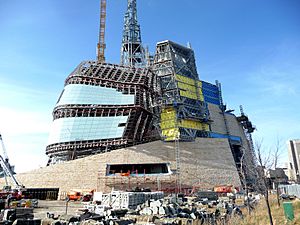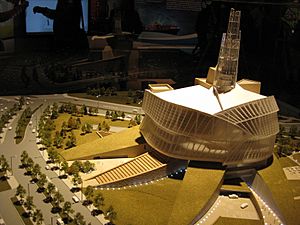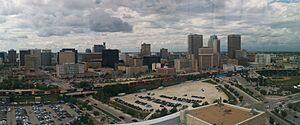Canadian Museum for Human Rights facts for kids
| Musée canadien pour les droits de la personne | |
 |
|

Canadian Museum for Human Rights in 2014
|
|
| Established | 13 March 2008 |
|---|---|
| Location | The Forks, Winnipeg, Manitoba, Canada |
| Type | Human rights museum |
| Visitors | 295,300 (2016/17) |
| Founder | Israel Asper and The Asper Foundation |
| Owner | Government of Canada |
|
Building details
|
|
| General information | |
| Groundbreaking | 19 December 2008 |
| Construction started | 2009 |
| Cost | $351 million |
| Height | |
| Observatory | 100 m (328.08 ft) |
| Technical details | |
| Material | alabaster, basalt rock, glass, Tyndall limestone, steel |
| Floor count | 8 |
| Floor area | 24,155 m2 (5.97 acres) |
| Lifts/elevators | 3 |
| Design and construction | |
| Architect | Antoine Predock |
| Awards and prizes | 14 national & international awards related to its architecture and construction |
| Other information | |
| Number of restaurants | 1 (ERA Bistro) |
| Agency overview | |
| Type | Crown corporation |
| Minister responsible |
|
| Key document |
|
The Canadian Museum for Human Rights (CMHR) is a special museum in Winnipeg, Manitoba, Canada. It is located next to a historic area called The Forks. This museum is Canada's first national museum built outside the capital city.
The main goal of the museum is to teach people about human rights. It helps everyone understand human rights better. It also encourages respect for others and helps people think and talk about these important topics. The museum officially opened its doors on September 19, 2014.
Contents
Exploring Human Rights in Canada
How the Museum Started
The idea for the Canadian Museum for Human Rights came from a Canadian lawyer named Izzy Asper. He first thought of building this museum in 2000. Mr. Asper wanted a place where students from all over Canada could learn about human rights.
He also hoped the museum would help make downtown Winnipeg a more exciting place. It was meant to bring more visitors to the city. Most importantly, he wanted to raise awareness about human rights. He hoped it would encourage people to respect others and take action.
In 2003, Mr. Asper created a group called the Friends of the Canadian Museum for Human Rights. This group helped raise money to build the museum. The Canadian government, the province of Manitoba, and the city of Winnipeg all helped. The land for the museum was also donated.
Sadly, Izzy Asper passed away in 2003. His family, especially his daughter Gail Asper, continued his dream. They kept working to make the museum a reality.
Choosing the Design
The Friends of the CMHR held a big competition to choose the museum's design. Architects from 21 countries sent in their ideas. The winning design came from Antoine Predock, an architect from the United States.
A company called Ralph Appelbaum Associates was hired to create the museum's exhibits. They are known for designing museum displays around the world.
Building the Museum
On April 20, 2007, the Canadian government announced that the CMHR would become a national museum. This was a big step! On March 13, 2008, a law was passed to make it official. This meant the CMHR joined other important national museums in Canada.
Before construction began, archaeologists worked with Indigenous Elders. They carefully dug up the land and found over 400,000 artifacts. This showed respect for the ancestral lands.
Construction officially started on December 19, 2008. On July 3, 2010, Queen Elizabeth II visited the site. She placed a special stone from Runnymede, England, into the museum's foundation. This stone came from the place where the Magna Carta was signed in 1215.
By the end of 2012, the main building was finished. The museum officially opened in 2014. A road in front of the museum was named "Israel Asper Way" to honor its founder.
Opening Day and Feedback
The museum's grand opening was on September 20, 2014. Some groups protested during the opening. They felt that their own human rights stories were not fully or accurately shown in the museum. For example, the musical group A Tribe Called Red chose not to perform. They were protesting the museum's coverage of Indigenous issues.
Funding the Museum
The money to build the CMHR came from different sources. The Canadian government, the Manitoba government, and the City of Winnipeg all contributed. Private donations also played a huge part.
The total cost to build the museum was about $351 million. The Canadian government gave $100 million. The Manitoba government donated $40 million, and the City of Winnipeg gave $20 million.
The Friends of the Canadian Museum for Human Rights group, led by Gail Asper, raised over $130 million from private donors. This shows how many people supported the museum's creation. The Canadian government also provides money each year to help the museum operate.
The Museum's Architecture
The museum building itself is very unique. The ground floor has a gift shop, a restaurant, and places for visitors to get help. Inside, visitors move between different levels using ramps made of glowing alabaster. This area is called the Hall of Hope.
There is also a peaceful Garden of Contemplation. It has calm pools of water and dark black rocks. The museum journey ends at the Israel Asper Tower of Hope. This tall glass tower is 100 meters high. From the top, visitors can see amazing views of downtown Winnipeg.
The Architect's Vision
Antoine Predock designed the museum to feel like a journey. He imagined visitors entering through the "roots" of the museum, deep in the earth. They then travel through large spaces and ramps. The journey finishes at the "Tower of Hope," which reaches up to the sky.
Predock was inspired by Canada's natural beauty. He thought about trees, ice, the northern lights, and Indigenous peoples. He wanted the building to show how human rights are deeply connected to humanity. He described the museum as "a symbolic apparition of ice, clouds and stone."
During construction, special "medicine bags" were placed in the ground. This was done by Elders from Thunderbird House in Winnipeg. It showed respect for Mother Earth. The Hall of Hope used over 15,000 pieces of alabaster. This made it the largest project ever done with this glowing stone.
Exhibits and Learning
What You Can See Inside
The CMHR worked with a company called Ralph Appelbaum Associates to create its exhibits. The galleries cover many different topics related to human rights. These include Canada's human rights journey and Indigenous ideas about human rights. They also explore the the Holocaust and current human rights issues around the world.
The museum wanted to hear from Canadians about what stories to include. They traveled to 19 cities and talked to thousands of people. This helped them decide what to show in the museum. The largest gallery focuses on Canadian human rights stories.
Main Galleries to Explore
Since opening in 2014, the museum has had 10 main galleries:
- What are human rights? This gallery helps you understand the basic ideas of human rights.
- Indigenous perspectives. This section includes a film about Indigenous ideas of rights and responsibilities. It also features a large ceramic artwork called "Trace" by artist Rebecca Belmore.
- Canadian journeys. This gallery highlights important moments in Canadian history. It includes exhibits on residential schools, missing and murdered Indigenous women, and the forced relocation of Inuit. It also covers the experiences of Japanese Canadians during World War II, the Chinese head tax, and the Underground Railroad.
- Protecting rights in Canada. This gallery looks at how rights are protected in Canada.
- Examining the Holocaust and other genocides. This gallery explores five genocides recognized by Canada. These include the Holocaust, the Holodomor, the Armenian genocide, the Rwandan genocide, and the Bosnian ethnic cleansing.
- Turning points for humanity. This section looks at major moments in human rights history.
- Breaking the silence. This gallery focuses on speaking up against injustice.
- Actions count. This part shows how individual actions can make a difference.
- Rights today. This gallery explores current human rights issues.
- Inspiring change. This section encourages visitors to take action for human rights.
Indigenous issues are woven throughout all the galleries. They are especially highlighted in the "Canadian Journeys Gallery" and the "Indigenous Perspectives Gallery."
Museum Partnerships
The CMHR works with many different groups. These partnerships help the museum provide even better information and learning opportunities. Here are some of the organizations that have partnered with the museum:
- University of Manitoba
- University of Winnipeg
- National Museum – "Memorial to Holodomor victims" (Kyiv, Ukraine)
- Canadian Association of Statutory Human Rights Agencies
- Ambassador of the Kingdom of the Netherlands to Canada (Netherlands Embassy)
- Library and Archives Canada
- The Manitoba Museum
- Manitoba Education (the Province of Manitoba)
See also




